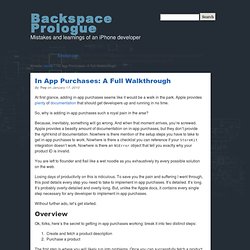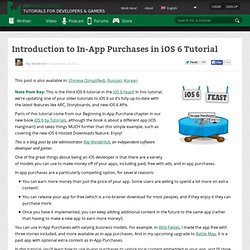

In App Purchases: A Full Walkthrough. At first glance, adding in-app purchases seems like it would be a walk in the park.

Apple provides plenty of documentation that should get developers up and running in no time. So, why is adding in-app purchases such a royal pain in the arse? Because, inevitably, something will go wrong. And when that moment arrives, you’re screwed. Apple provides a beastly amount of documentation on in-app purchases, but they don’t provide the right kind of documentation. You are left to flounder and flail like a wet noodle as you exhaustively try every possible solution on the web. Losing days of productivity on this is ridiculous. Without further ado, let’s get started. Overview Ok, folks, here’s the secret to getting in-app purchases working: break it into two distinct steps: Create and fetch a product descriptionPurchase a product The first step is where you will likely run into problems.
We’ll tackle the product description step first. Create and Fetch a Product Description 1. This is a unique App ID: 2. Things I learned implementing my first InAppPurchase. Yesterday I sent my first app off to Apple containing an InAppPurchase (IAP).

It’s a free app that gives the user an option to pay a dollar for a premium features. That’s what they call Freemium these days. Free to try, premium to get some more. The possibility for Freemium was only introduced in October 2009 when Apple finally gave in to developer’s wish to be able to do away with those dreaded Lite versions which have a very low conversion rate (about 1%) anyway. Until that time IAPs where only available for paid apps. After developing on the premium content for about two weeks I hit my first roadblock. If you are looking for a full walkthrough, this is not the article to provide that. Double App Identifier Trouble For sake of simplicity I’ve been using the wildcard app identifier on all my published apps and did not have any problems with this approach. In our case it was our own mistake. Setting up in Program Portal You have a choice of three variants: non-consumable.
Nuts & Bolts. Introduction to In-App Purchases. This post is also available in: Chinese (Simplified), Russian, Korean Note from Ray: This is the third iOS 6 tutorial in the iOS 6 Feast!

In this tutorial, we’re updating one of your older tutorials to iOS 6 so it’s fully up-to-date with the latest features like ARC, Storyboards, and new iOS 6 APIs. Parts of this tutorial come from our Beginning In-App Purchase chapter in our new book iOS 6 by Tutorials, although the book is about a different app (iOS Hangman!) And takes things MUCH further than this simple example, such as covering the new iOS 6 Hosted Downloads feature. Enjoy! This is a blog post by site administrator Ray Wenderlich, an independent software developer and gamer.
One of the great things about being an iOS devleoper is that there are a variety of models you can use to make money off of your apps, including paid, free with ads, and in-app purchases. In-app purchases are a particularly compelling option, for several reasons: In App Rage Managing In App Purchases Consumables.